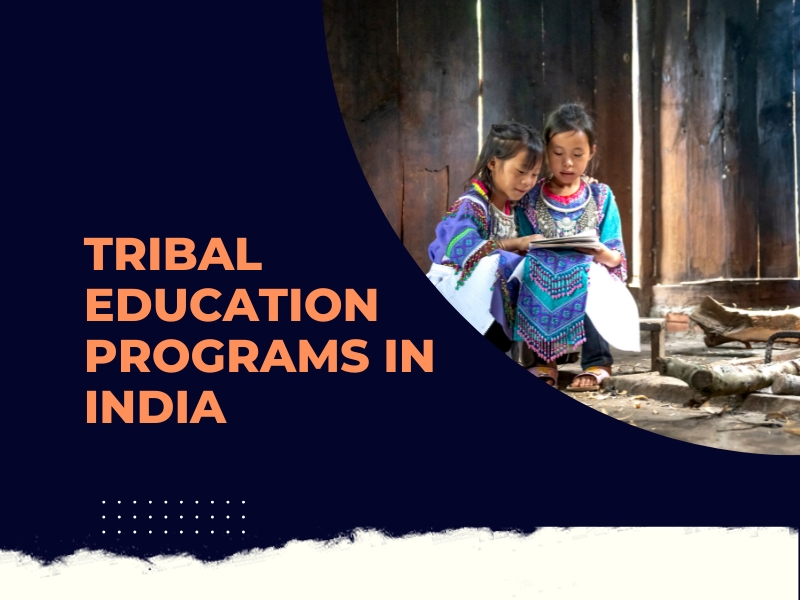Tribal education programs in India stand as crucial initiatives undertaken to uplift and empower indigenous communities while promoting socio-economic development. For generations, tribal populations have grappled with historical marginalization, limited access to quality education, and the threat of cultural erosion. Acknowledging the profound significance of preserving their unique heritage and fostering inclusive growth, the Indian government, along with various organizations, has embarked on numerous endeavours to enhance educational opportunities for these communities. Through these concerted efforts, the aim is to bridge educational disparities, empower marginalized tribal populations, and pave the way for a brighter future, where the richness of their cultural heritage is celebrated, and their contributions to society are fully realized. This article delves into the comprehensive tribal education programs in India, their transformative impact, and the progressive steps taken to ensure the holistic development of these resilient and vibrant communities.
Bridge Schools and Residential Schools
Bridge schools and residential schools are essential components of India’s efforts to bridge the educational gap and increase school enrollment among tribal communities. In remote tribal areas where access to formal education is limited, the government has established bridge schools to provide a foundational education in the student’s mother tongue. These schools aim to prepare students for the transition into mainstream formal education gradually. By offering instruction in their native language, students can better grasp concepts and build a strong educational foundation. As part of the broader initiative, residential schools have also been set up to accommodate children from remote regions. These schools provide a safe and conducive learning environment, allowing children to access quality education without having to travel long distances. The residential school setup ensures that students from tribal communities have the necessary support and resources to pursue their education effectively. Through the establishment of bridge schools and residential schools, the government strives to promote inclusive and equitable education, empowering tribal children with the knowledge and skills necessary for a brighter future.
Mother Tongue-Based Multilingual Education (MTB-MLE)
Mother Tongue-Based Multilingual Education (MTB-MLE) is a significant initiative undertaken in India to promote inclusive and culturally responsive education for tribal children. Recognizing the importance of the mother tongue in preserving cultural heritage, MTB-MLE programs aim to teach students their native languages during the early years of education. This approach has been proven to enhance students’ learning outcomes and comprehension, as they can better grasp concepts when taught in a language they are familiar with. By using the mother tongue as the medium of instruction, MTB-MLE initiatives not only facilitate effective learning but also strengthen cultural identity and pride among tribal communities. Students feel a sense of belonging and are more engaged in the learning process, as their cultural context is integrated into the curriculum. MTB-MLE programs empower tribal children to embrace their linguistic and cultural heritage, fostering a positive and inclusive learning environment where diversity is celebrated. As a result, students are better equipped to navigate the challenges of education and become active participants in their communities socio-economic development.
Teacher Training Programs
Teacher training programs in tribal communities play a vital role in enhancing the quality of education and promoting cultural sensitivity among educators. These specialized programs are designed to equip teachers with the necessary knowledge and skills to effectively teach students from diverse cultural backgrounds. They focus on understanding the unique needs and challenges faced by tribal communities, as well as the cultural nuances that influence students’ learning experiences. Through these training programs, teachers learn how to incorporate local traditions, languages, and customs into their teaching practices, making the curriculum more relevant and engaging for tribal students. Moreover, educators are trained in effective pedagogical methods that cater to the specific learning styles and abilities of their students. By sensitizing teachers to the cultural context of their students and providing them with the tools and strategies to create inclusive and culturally responsive classrooms, these training programs contribute to improving the overall educational outcomes and fostering a positive learning environment in tribal communities.
Scholarship Schemes and Incentives
Scholarship schemes and incentives have proven to be significant drivers in promoting higher education among tribal students in India. These initiatives aim to address the economic challenges faced by marginalized communities and ensure equal access to quality education. The government and various organizations have introduced a range of scholarship programs tailored to the needs of tribal students. These scholarships cover tuition fees, provide financial assistance for books and educational materials, and offer stipends to support living expenses. Additionally, many scholarship schemes also include hostel facilities to provide a safe and conducive living environment for tribal students pursuing education away from their homes. By alleviating financial burdens and offering support, these initiatives empower tribal youth to overcome barriers and pursue their academic aspirations, contributing to a more inclusive and educated society.
Vocational Training and Skill Development
Vocational training and skill development programs have emerged as transformative tools in uplifting tribal communities by providing them with practical skills and hands-on training. These initiatives are designed to align with the specific needs and demands of the job market, ensuring that tribal youth are equipped with relevant and employable skills. Various government agencies, non-governmental organizations, and private sector partners collaborate to offer a diverse range of vocational courses, such as carpentry, weaving, agriculture, healthcare, and hospitality, among others. The programs often include both classroom learning and practical training to prepare students for real-world challenges. By fostering entrepreneurship and income-generating opportunities, vocational training plays a pivotal role in reducing poverty and improving the socioeconomic status of tribal communities. Through these initiatives, tribal youth gain the confidence and competence to contribute actively to their communities and the broader economy, promoting sustainable development and self-reliance.
Digital Initiatives and E-Learning
Digital initiatives and e-learning have emerged as powerful tools in democratizing education and bridging the educational divide in tribal regions. The Indian government’s Digital India campaign has paved the way for the integration of technology into the education sector, reaching even the most remote tribal communities. Various e-learning platforms and educational apps have been developed, providing students with access to a wide range of academic resources, including interactive lessons, video tutorials, and digital textbooks. Additionally, virtual classrooms and online teacher training programs have been introduced to enhance the quality of education and professional development for educators in tribal areas. Through digital initiatives, students can explore diverse subjects, participate in interactive learning experiences, and stay updated with the latest knowledge and advancements. These initiatives not only enrich the learning experience but also empower tribal youth with the knowledge and skills needed to thrive in a rapidly evolving world.
Community Engagement
Community engagement lies at the heart of effective tribal education programs in India. Recognizing the significance of involving local communities in the educational process, various initiatives have been designed to promote active collaboration and participation. Community engagement not only builds trust and mutual understanding but also ensures that educational programs are culturally sensitive and relevant to the needs of the tribal population. By involving community elders, leaders, and parents in decision-making and planning, educational initiatives become more inclusive and sustainable. These programs empower the community to take ownership of their children’s education, leading to a greater sense of responsibility and investment in the educational journey. Additionally, community engagement fosters a supportive learning environment, where students feel connected to their cultural roots and are motivated to excel in their studies. The active involvement of the community in tribal education programs lays the foundation for a brighter and more empowered future for tribal youth.
Conservation of Traditional Knowledge
Conservation of traditional knowledge is a fundamental aspect of certain tribal education programs in India. These initiatives recognize the importance of preserving indigenous practices and traditional ecological knowledge, which have been passed down through generations. By integrating traditional knowledge into the curriculum, students gain a deeper understanding of their cultural heritage and the environment they inhabit. Moreover, this approach fosters a sense of respect for nature and promotes sustainable practices, contributing to ecological conservation efforts. Through hands-on learning and engagement with their surroundings, students become stewards of their land and resources, ensuring the continuity of their traditional practices for future generations. The conservation of traditional knowledge in tribal education programs not only empowers the community but also strengthens the connection between indigenous communities and their natural environment.
Conclusion
In conclusion, tribal education programs in India stand as a testament to the nation’s commitment to empowering marginalized communities and preserving cultural diversity. By addressing the unique needs and challenges faced by tribal populations, these initiatives pave the way for inclusive growth and socio-economic development. Through mother tongue-based multilingual education, vocational training, and digital initiatives, India’s efforts aim to bridge the educational divide and unlock the potential of tribal youth. Moreover, the integration of traditional knowledge and community engagement further strengthens the fabric of indigenous cultures, fostering a sense of pride and identity. As India progresses towards a more equitable and inclusive future, the preservation of tribal languages, customs, and ecological wisdom becomes an integral part of the nation’s rich tapestry of cultural heritage. By nurturing education and embracing diversity, India embraces the strength of its tribal communities and embraces a brighter future for all.

